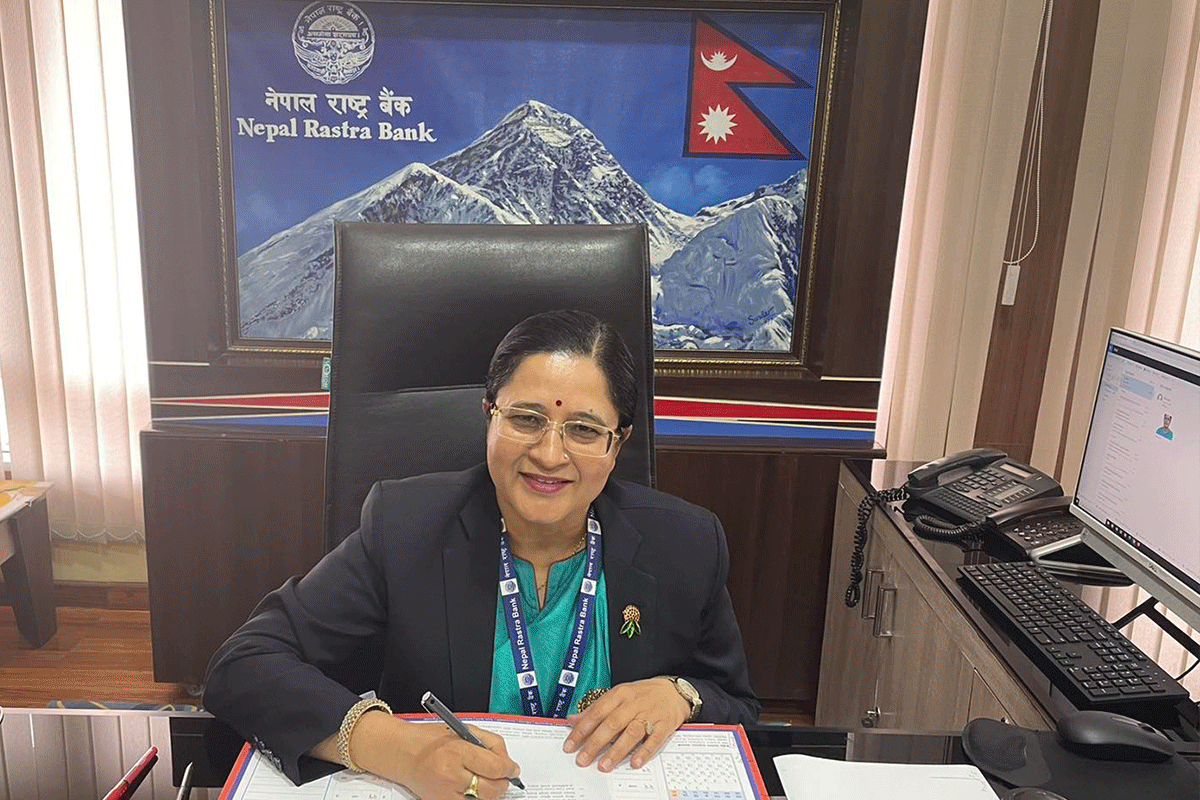
The government appointed Neelam Dhungana Timsina and Bam Bahadur Mishra as Deputy Governors of Nepal Rastra Bank in March this year. Dhungana who has served in various positions during her long career with the Central Bank now holds the distinction of being the first female in NRB’s 65 year history to become the Deputy Governor. Business 360 caught up with Dhungna to learn about her views on what constitutes a stable, inclusive and resilient financial system in Nepal. Excerpts:

How do you feel being the first female to be appointed Deputy Governor of Nepal Rastra Bank in its 65 plus years history?
I feel great pride to have become the first female Deputy Governor of the Nepal Rastra Bank in its long history. It is also a pride for all the female employees as it proves that women can have the opportunity to lead if they prove themselves capable, honest, patient and having high level of integrity.What are your priorities as the Senior Deputy Governor of the Nepal Rastra Bank?
The assignments of the Deputy Governors are well defined. As the senior Deputy Governor, I have been assigned the responsibilities of the Banks and Financial Institutions Regulation Department, Foreign Exchange Management Department, Payment System Department, Information and Technology Department, Public Debt Management Department, Banking Operation Department, Human Resource Management Department and Financial Management Department. Nepal Rastra Bank Act 2058 clearly states the main objectives of the bank. First is to formulate the necessary monetary and foreign exchange policies in order to maintain the stability of balance of payments for economic stability and for sustainable development and management of the economy. Second is to increase the access of financial services and increase public confidence towards the banking and financial systems. Third is to develop a secure, healthy and efficient system of payment. As a Senior Deputy Governor, my priorities are directed in line with these objectives. I would specifically like to focus on consolidating the financial sectors, strengthening the financial regulations and thereby maintaining financial stability, developing a secure, healthy and efficient payment system in the context of increasing digitisation. Especially in the context of the second wave of the pandemic, my immediate priorities are to continue the recent policy measures taken by the NRB to further support the ongoing recovery while preserving financial stability.The country’s economy has faced sever setbacks due to the pandemic. How do you assess the stress faced by the financial sector?
It is known to all that the financial sector is directly linked with the other crucial sectors of the economy. The shocks in the other sectors quickly pass onto and synchronize with the financial sector. The financial sector also holds the capacity of reviving the economy in a crisis by mobilizing financial resources in potential sectors. That is the reason why it should remain highly resilient for the revival of the economy. It is always a great challenge to precisely forecast and also to assess and calculate crisis or whether it can ride out a crisis or not, this it turns out is almost next to impossible especially during the current pandemic. Undertaking feasible policy measures to make sure that the financial sector performs continuously to help recover the economy stands as a huge challenge. The sector faced severe setbacks due to the pandemic witnessing weak quality of risk based assets. Borrowers cash flow mismatched due to the stoppage of business cycles which jeopardized their cash conversion cycles making them unable to meet their debt service capacities. In addition, there were no new demands for loan due to uncertainty in the investment climate. In such scenario, it was found that the survival of the real sector was a must for the sustainability of the financial sector and pivotally that’s the reason why Nepal Rastra Bank adopted various conventional as well as unconventional policy measures in order to provide relaxation to affected industries, to businesses and to BFIs as well. It is certain that these interventions helped a lot to withstand financial distress and mitigate high risks. The timeliness of the action is evident from their financial performance reports.
What is the Central Bank doing to ensure a sound and stable financial system?
The NRB has taken a number of measures to bolster the financial sector which was stressed by the pandemic. Liquidity related measures such as reduction in cash reserve ratio (CRR), reduction in bank rate, increase in CCD ratio helped to ease the liquidity position in the market. In order to maintain the asset quality of BFIs, measures of relaxation on asset classification and provisioning for downgraded loans as well as conditional loan restructuring and rescheduling were allowed. The macro prudential measures of suspending counter-cyclical buffer for one year helped BFIs to control the stress over capital. Similarly, time extension of moratorium on interest and principal repayment, concession on interest, availability of upfront working capital loans, refinancing facility, business continuity loan are Covid 19 targeted measures that helped industries stay operational and alive. NRB has always been proactive to ensure smooth operation of the financial sector in difficult economic situations. The NRB will continue to accommodate policies if the days to come show the need for it. The Central Bank is also very much aware and cautious about the possible moral hazards, chances of subprime lending, funds being rechannelled for recovery, and several other imprudent activities during such volatile situation. It’s expected that there may be some rise in non performing portfolio and stress on liquidity and capital. However, NRB will definitely provide timely interventions at the policy level.How long can the central bank extend such facilities without severe implications on the financial system?
NRB formulates Monetary Policy taking into account domestic as well as international economic outlook along with government budget for the next fiscal year. NRB uses suitable policy instruments to drive the economy towards intended direction. We know that the Monetary Policy 2020/21 has contributed well in maintaining macroeconomic and financial stability besides addressing the unconventional needs of the economy. It has delivered on people’s expectations from public policies as well. Society was moving into a new normal and the business sector was improving significantly. A survey of NRB on Covid 19 impact on the economy conducted from mid-November to mid-December 2020 showed that 54% of industrial activities and businesses had come into full operation and their production/transaction level had reached 50% when compared to pre-Covid 19 period. The deposit and credit growth in recent months was really impressive. But we all are shocked by the second wave of Covid 19. Considering the unexpected challenge of the second wave, NRB will undertake rigorous exercise in formulating the Monetary Policy for the next year. NRB will assess the impact of the previous policy and programs while formulating the new policy. NRB gives priority to expanding economic activities for the speedy recovery of the economy. However, NRB cannot compromise its prime responsibility of macroeconomic and financial stability. I want to assure all that NRB plays its role in addressing the unconventional needs of economy along with maintaining macroeconomic and financial stability.What are the prime suggestions for the budget to the government?
As financial advisor of the government, NRB gives pre-budget suggestions along with assessments and projections of the economy. The NRB prepares pre-budget suggestions making rigorous assessments and holding consultations with stake holders. The top priority will definitely be economic recovery. We suggest adopting prudential fiscal rules for macroeconomic stability. Besides, we have suggestions for increasing infrastructure financing. Also financial access and digitization should be the priority of government as well as the Central Bank.What are the areas where fiscal and Monetary Policy can be aligned to cope with the crisis?
This is crucial question in the present context. In fact, most governments and central banks are working together for faster recovery of economy. We have to establish proper coordination between monetary and fiscal policy in channeling relief measures effectively avoiding duplication. We should also be careful in prospective imbalances due to over reliance on any sector. Ultimately, we have crucial responsibility of priority setting taking into account actual and probable impact of Covid on the economy.Some experts have suggested that the Central Bank has an option to issue repo against the collateral of government securities as underlying asset for the medium term like the Reserve Bank of India introduced recently. What are your thoughts?
Central banks have implemented several unconventional and substandard measures to combat the Covid 19 crisis. Considering the liquidity and financial conditions, RBI has decided to conduct simultaneous purchase and sale of government securities under Open Market Operations (OMO). In our case also we have adopted suitable measures for liquidity management. We have revised refinance procedure and extended the refinance facilities significantly. We provide refinance facilities for a year and there is provision of renewal as well. There has been adequate liquidity in the banking system since last year. There is balance in growth of deposits and credits. We have provision of long-term repo as well. In my view, we should not think of another alternative in this situation.The Central Bank has expanded available funding from the refinancing window. This facility is highly utilised with Rs 142 billion out of the available Rs. 190 billion used by mid-April. The chunk of refinancing is from non funded sources because the Central Bank has only Rs 30-40 billion in funded source. Can you explain?
Expansion of refinance fund is an unconventional tool used by the Central Bank to ease entrepreneur difficulties created mainly by the ongoing pandemic that might otherwise have hampered the stability of the financial system. To create a larger room for such support, the bank decided to utilize the available fund of Rs. 42.5 billion as risk bearing fund and created loans against the same for providing refinance facility to customers. This limit was set at five times by our policy. Refinance definitely worked as the first aid to the sectors hard hit by the crisis but is not a permanent solution. That’s why the loans disbursed will eventually be absorbed as the situation improves. Besides, the manuals also spell out the exit policy from this unconventional tool. As the effect of pandemic neutralises in the days to come, the bank will certainly limit this facility to the available fund as the bank was doing before the pandemic. The bank is aware about not disrupting the liquidity scenario in the market, and it also not simply just withdraw the fund at once. It’s will be gradually done. In case the situation gets worse there is no choice but to support the financial system through unconventional means for quite a longer period. Nonetheless, it should be understood that the subsidized loan and refinance are totally separate measures with separate objectives and both of them are supported by separate sources. Subsidized credits are funded by the Government of Nepal. In case of requirement of more support, the same will be addressed by the government through the allocation of adequate budget. As far as refinancing is concerned, NRB Act prescribes the refinance support be provided to the customer for a maximum duration of one year. There is also a provision of renewal if needed. Thus, upon maturity of the stated period the same fund will be available for other customers. The financial system will be supported as well as the industries through this fund. As mentioned earlier the bank will downsize the fund as the situation normalises.What is the Central Bank doing to ensure reliability, trust, security of data, digital literacy and building the ecosystem so that more people can be benefited from digital banking and payment systems that have emerged aggressively in the pandemic?
The Digital Banking/Payment System has emerged as an inevitable system after the country has encountered the pandemic. The Central Bank is carrying out various functions to ensure that the payment system is reliable, efficient, trustworthy and secured to its highest degree of optimality. The Central Bank is also working to promote financial literacy and build an ecosystem that benefits the country as a whole when it comes to financial knowledge competence and financial discipline. The Central Bank’s role during the pandemic has increased immensely and the bank has taken various measures to promote digital transactions. Digital payment system is backed by strong legal and regulatory frameworks: Payment Systems Act, Bylaws and Unified Directives. There are ten Payment Service Operators (PSOs) and 28 Payment Service Providers (PSPs) to serve people including RTGS in NRB. Customers have choice in terms of different institutions and instruments that are available 24X7. Real Time Goss Settlement (RTGS) for large value is in operation. Likewise, grievance handling mechanism stands rigorous and the Central Bank has also developed strong and forward-looking oversight towards digital payment system that gives full of trust to customers. Regarding the security of data, institutions are required to formulate data/information security policy. We are giving emphasis on hardware/software security. Apart from that, to ensure secured transactions it requires two factor authentications while making transactions. Central Bank has made audit system regular and mandatory. Mandatory International Standards such as PCI, DSS & ISO have been introduced. In terms of literacy, directives on consumer protection have been issued. BFIs are allowed to promote digital payments through CSR expenses and NRB along with PSO/PSP to engage in consumer literacy campaigns.
Published Date: May 29, 2021, 12:00 am
Post Comment
E-Magazine
RELATED Face 2 Face





